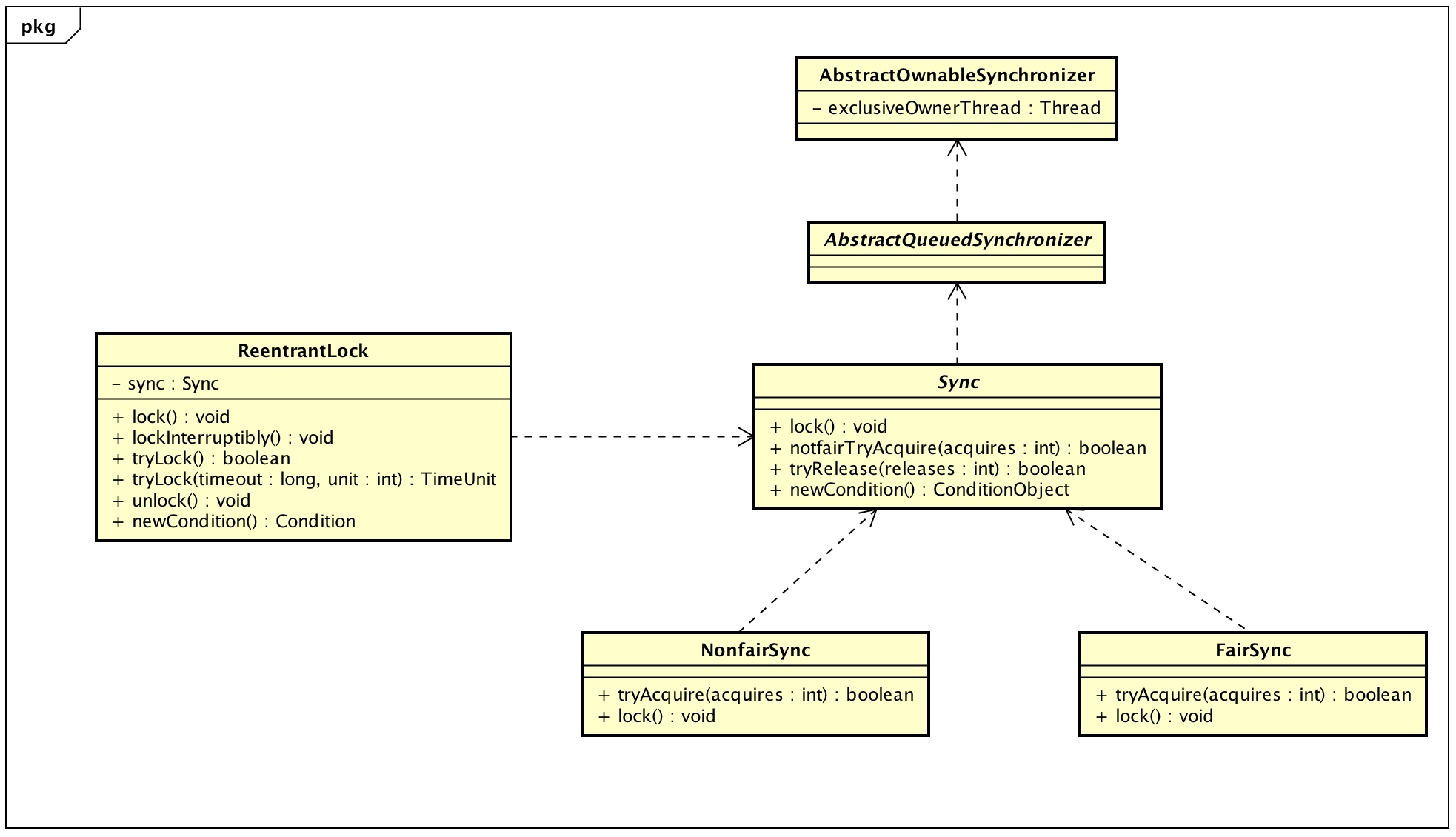java學習之ReentrantLock
本篇博文主要記錄ReentranctLock內部實現原理。
ReentrantLock和Synchronized關鍵字相比,使用起來比較靈活。如何使用ReentranctLock就不多講了,這裏主要記錄ReentrantLock的內部實現原理。
首先看下ReentrantLock的類繼承結構, 如下圖:

ReentrantLock內部有三個內部類: Sync, FairSync, NonfairSync. 源碼如下:
Sync:
abstract static class Sync extends AbstractQueuedSynchronizer {
private static final long serialVersionUID = -5179523762034025860L;
/**
* Performs {@link Lock#lock}. The main reason for subclassing
* is to allow fast path for nonfair version.
*/
abstract void lock();
/**
* Performs non-fair tryLock. tryAcquire is implemented in
* subclasses, but both need nonfair try for trylock method.
*/
final boolean nonfairTryAcquire(int acquires) {
final Thread current = Thread.currentThread();
int c = getState();
if (c == 0) {
if (compareAndSetState(0, acquires)) {
setExclusiveOwnerThread(current);
return true;
}
}
else if (current == getExclusiveOwnerThread()) {
int nextc = c + acquires;
if (nextc < 0) // overflow
throw new Error("Maximum lock count exceeded");
setState(nextc);
return true;
}
return false;
}
protected final boolean tryRelease(int releases) {
int c = getState() - releases;
if (Thread.currentThread() != getExclusiveOwnerThread())
throw new IllegalMonitorStateException();
boolean free = false;
if (c == 0) {
free = true;
setExclusiveOwnerThread(null);
}
setState(c);
return free;
}
...
}
FairSync:
static final class FairSync extends Sync {
private static final long serialVersionUID = -3000897897090466540L;
final void lock() {
acquire(1);
}
/**
* Fair version of tryAcquire. Don‘t grant access unless
* recursive call or no waiters or is first.
*/
protected final boolean tryAcquire(int acquires) {
final Thread current = Thread.currentThread();
int c = getState();
if (c == 0) {
if (!hasQueuedPredecessors() &&
compareAndSetState(0, acquires)) {
setExclusiveOwnerThread(current);
return true;
}
}
else if (current == getExclusiveOwnerThread()) {
int nextc = c + acquires;
if (nextc < 0)
throw new Error("Maximum lock count exceeded");
setState(nextc);
return true;
}
return false;
}
}
NonfairSync:
static final class NonfairSync extends Sync {
private static final long serialVersionUID = 7316153563782823691L;
/**
* Performs lock. Try immediate barge, backing up to normal
* acquire on failure.
*/
final void lock() {
if (compareAndSetState(0, 1))
setExclusiveOwnerThread(Thread.currentThread());
else
acquire(1);
}
protected final boolean tryAcquire(int acquires) {
return nonfairTryAcquire(acquires);
}
}
FairSync實現了公平鎖邏輯, NonfairSync實現的是非公平鎖的邏輯。 下面看下最常使用的非公平鎖的實現。
NonfairSync.lock()方法,首先基於CAS設置AQS中的state,如果返回true, 說明獲取成功,此時將排他線程設置為當前線程。如果返回false, 說明獲取失敗,調用acquire(1)方法。acquire()方法在AQS中,代碼如下:
public final void acquire(int arg) {
if (!tryAcquire(arg) &&
acquireQueued(addWaiter(Node.EXCLUSIVE), arg))
selfInterrupt();
}
在acquire中首先再次獲取鎖, 如果獲取失敗, 則調用addWaiter()方法,將當前線程加入CHL隊列。CHL隊列結構如下:

加入隊列後,然後調用方法acquireQueued(), 代碼如下:
final boolean acquireQueued(final Node node, int arg) {
boolean failed = true;
try {
boolean interrupted = false;
for (;;) {
final Node p = node.predecessor();
if (p == head && tryAcquire(arg)) {
setHead(node);
p.next = null; // help GC
failed = false;
return interrupted;
}
if (shouldParkAfterFailedAcquire(p, node) &&
parkAndCheckInterrupt())
interrupted = true;
}
} finally {
if (failed)
cancelAcquire(node);
}
}
在acquireQueued()方法中,首先判斷當前節點的前置節點是不是頭結點,如果是頭結點,則嘗試獲取鎖,獲取成功,則當前節點設置為頭結點。否則判斷是否應該講當前節點對應的線程掛起, 如果前一個前一個節點的status是SIGNAL, 則說明需要將當前節點掛起。調用parkAndCheckInterrupt()方法掛起當前節點的線程。
上面是非公平鎖的lock()邏輯,公平鎖和非公平鎖的,區別主要是公平鎖在獲取之前,首先需要判斷是否存在前置節點,如果存在前置節點,則需要等待。我們看到FairSync中的tryAcquire()方法中,首先調用了hasQueuedPredecessors()方法,判斷是否存在前置節點。
java學習之ReentrantLock
